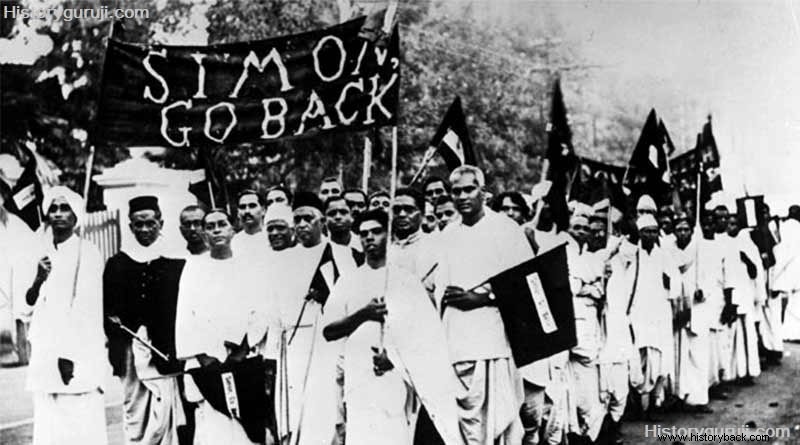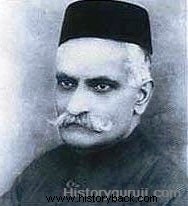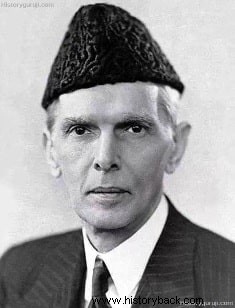On 8 November 1927, the Tory government of London announced the formation of the Simon Commission, a seven-member constitutional commission to review the working of the constitutional system in India.
The Government of India Act of 1919 provided that after 10 years a commission would be appointed, which would review the constitutional progress made by this act.
The reason for the premature formation of the Simon Commission was that general elections were to be held in England in the near future and the Tory government did not want the commission to be formed by the incoming government. In April 1926, the Minister of India wrote to Viceroy Irwin:'' We can't take the risk that 1927 Let the nomination of the commission of rest in the hands of our successors .
The task of the Simon Commission was to review the progress of the Act of 1919 and recommend whether India is capable of giving more constitutional rights to its people? And if given, what is its form?
Simon Commission Commission Sir John Simon It was constituted under the chairmanship of the President, all the members of which were drawn from the British Parliament. The names of the members of the commission were- Sir John Simon , Clement Atlee , Harry Levy-Lawson , Edward Cadogan , Vernon Hartshorne , George Lane-Fox , Donald Howard .
Like the Rowlatt Act of 1919, the announcement of the formation of the Simon Commission added fuel to the fire to excite the people. As a result, the national movement which had stalled after the Chauri Chaura incident was revived with the announcement of the formation of the Simon Commission. All sections of Indians strongly opposed the formation of the Simon Commission because not a single Indian was placed in the Simon Commission.
Madras session of the Indian National Congress in 1927 M.N. Ansari presided. Congress in Madras session ' At every step , boycott of Simon Commission in every form ' decided. Muslim League and Hindu Mahasabha also decided to boycott Simon Commission along with Congress.
The Simon Commission reached Bombay on 3 February 1928. There was an all India strike against the Simon Commission and black flags were shown. Slogans of Simon go back (Simon go back) were echoed across the country. Wherever the Simon Commission went - Calcutta (Kolkata), Lahore, Lucknow, Vijayawada and Poona - huge crowds welcomed it by showing black flags at all places.
Protesters clash with police in Madras, shots fired and one person killed. Khalikuzzaman in Lucknow flew kites and balloons on the members of the Simon Commission by writing 'Simon go back'. While opposing the Simon Commission, Pandit Jawaharlal Nehru was injured and Govind Vallabh Pant was crippled by police lathis.
On 30 October 1928 in Lahore, youths opposing Simon led by Lala Lajpat Rai were brutally beaten up. During this protest Scott The Sher-e-Punjab beat up Lala Lajpat Rai mercilessly. In the end, Lala Lajpat Rai, who was badly injured, roared in the public meeting that, 'Today, every stick that rained down on me will become a nail in the coffin of the British.' Done.

Simon Commission Report (Simon Commission Report)
The Simon Commission published its report on 27 May 1930. The recommendations of the commission were as follows-
- Responsible governance should be established by abolishing the diarchy system implemented under the Government of India Act of 1919.
- Responsible government should be formed in all areas including law and order in the provincial area, but the time has not yet come for the formation of responsible government at the centre.
- Central legislature should be reconstituted, leaving the spirit of one unit and following the federal spirit, with its members indirectly elected by the provincial legislatures.
- The High Court should be put under the control of the Government of India.
- Burma (present-day Myanmar) should be separated from India and Orissa and Sindh should be given the status of a separate state.
- The number of members in the provincial legislatures should be increased.
- Governor and Governor General should take special care of the interests of minority castes.
- The system of appointing a constitution commission for revision every ten years should be abolished and a flexible constitution should be made for India, which evolves on its own.
Simon Commission report 'deserves to be thrown in the trash ' Was. But the biggest merit of this commission's report was that it was an intelligent study of India's problems and it provided a high-quality composition to the political library. Many of the recommendations of the Simon Commission report were implemented in the Government of India Act of 1935.
The boycott of Simon suddenly led to the formation of youth unions and organizations. To boycott it, labor-peasant parties were formed in many parts of the country, which were organizing and agitating among farmers and workers. Jawaharlal Nehru and Subhas Chandra Bose emerged as leaders in the wave of anti-Simon movement. Jawaharlal Nehru and Subhas Chandra Bose toured the country, addressed thousands of youth meetings and presided over innumerable meetings. The revolutionary movement, which had stopped due to the anti-Simon movement, also started rising again in North India and Bengal.
All Party Conference and Nehru Report , 1928 (All Party Conference and Nehru Report, 1928)
The Secretary of State, Lord Birkenhead, who appointed the Simon Commission, was constantly ranting that the Indian people were incapable of making a concrete proposal for constitutional reform that would be widely accepted by all Indians. Get political support.
Indian leaders Birkenhead's one ‘ unanimous constitution ' Challenge to make and organized an all-party conference of leaders of different ideologies of the country on 28 February 1928 in Delhi, which was presided over by Dr. Ansari. 29 organizations participated in this conference, but no decision could be taken due to mutual differences.
The next all-party conference was held on 19 May 1928 in Pune (Bombay). In this conference, a sub-committee of eight members was constituted under the chairmanship of Pt. Motilal Nehru to prepare the draft of the Indian Constitution, which included Sir Ali Imam, M.S. Ane, Tej Bahadur Sapru, Mangal Singh, Shoaib Qureshi, Subhash Chandra Bose, N.M. Joshi and G.P. Principal was involved. Motilal Nehru The sub-committee formed under the leadership of the famous 'Nehru Report in August 1928 after dozens of conferences and joint meetings ' Finalized.
Nehru Report , 1928 (Nehru Report, 1928)

'Nehru Report', released August 1928 The Congress leadership had a strong response to the challenge of the British government declaring Indians ineligible to frame a constitution. It introduced a unitary constitution for the whole of India, through which India would get full territorial autonomy in the center and the provinces. The major recommendations of the Nehru Report were as follows-
- The report suggested that India be made independent like other British colonies and given the right to establish a fully responsible government.
- The mischievous communal electoral system should be abandoned and a joint electoral system should be arranged in its place. In order to protect the interests of the Center and those states where Muslims are a minority, some places should be reserved (but this system should not be implemented in the provinces where Muslims are the majority, such as Punjab and Bengal).
- Provincial autonomy should be provided by abolishing diarchy in the provinces.
- The power should be divided between the center and the provinces on a federal basis, but the residuary powers should be given to the centre.
- Provinces should be formed on linguistic basis and Sindh province should be separated from Bombay.
- A Defense Committee, Supreme Court and Public Service Commission should be established in India.
- Indian Parliament or legislature should have two houses at the centre- lower house and upper house .Lower House (House of Representatives ) shall have 500 members and shall be elected by the method of direct election by adult suffrage. Upper House (Senate) The number of members should be 200 and its members should be indirectly elected by the provincial legislatures.
The head of the central government should be the Governor General and appointed by the British government. The Governor General will act on the advice of the Central Executive Council, which will be responsible to the Central Legislature. The term of the provincial legislatures will be five years and they will be headed by the governor, who will act on the advice of the provincial executive council.
- The rights and privileges of the native states should be ensured and only after the establishment of responsible government, any state should be included in the union.
Some other recommendations were also made in this report, such as suffrage for adults, equal rights for women, freedom to form unions and religion in all its forms. Separation from the state.
In fact the Nehru Report was a compilation of compulsion agreements and therefore stood on a weak foundation. The All Party Conference held in Calcutta in December 1928 did not accept this report because it contained ' Dominion States ' to the first target and 'Purna Swaraj ' second target Was declared. It was opposed by a militant youth party led by Jawaharlal Nehru and Subhas Chandra Bose. The land-rights of the king and landlords were protected in the fundamental rights of the citizens, due to which all the leaders of the country and the general public did not accept it.
Leaders of Muslim League, Hindu Mahasabha and Sikh League also had several objections to the report. A section of the Muslims was by all means abstaining from the proposal, and by the end of the year it became clear that the section headed by Muhammad Ali Jinnah was reserved for Muslims in Muslim-majority provinces. Wasn't going to give up on the demand for places.
Fourteen Point Requisition , March 1929 (Fourteen Demand Charter, March 1929)

'All Parties Muslim' on 1 January 1929 Almost all the reports of the Nehru Report were rejected. Although Jinnah did not attend the conference, he presented a fourteen-point charter of demands through the Muslim League as an alternative to the Nehru Report in March 1929. It includes federal constitution, provincial autonomy, establishment of Muslim majority in Punjab and Bengal, adequate representation of Muslims in central assembly and provincial cabinets and jobs, education of minorities, protection of culture and language, religious freedom to all communities, Sindh from Bombay. Demands such as separation were included.
Since the Muslims had rejected the basic tenets of the Nehru Committee report by their demands, it was impossible to establish unity between the Congress and the League. Thus the communal parties closed the door of national unity and after this there was a continuous growth of communalism.
Causes of Rise of Communalism in India
Civil Disobedience Movement and Gandhiji
